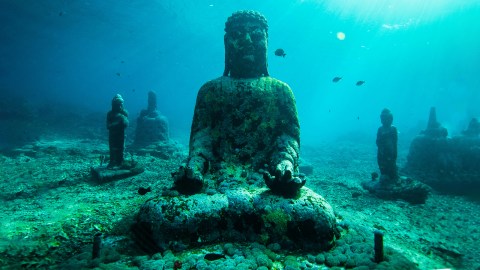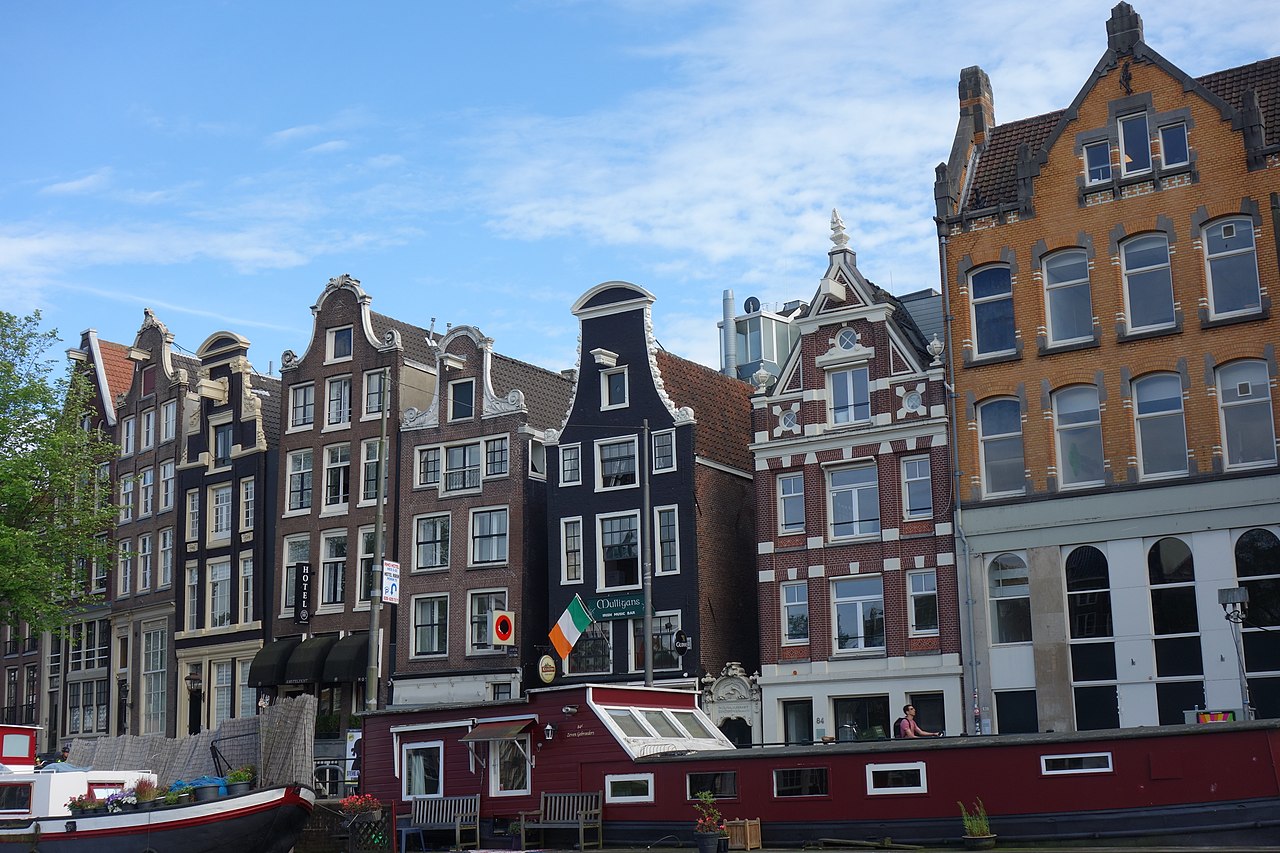The world heritage sites that were (or will be) swallowed by the sea

- Divers exploring near Antikythera discovered the severed head of a statue of Hercules.
- On the other side of the Aegean, archeologists are using sonars to map out the submerged neighborhoods of ancient Alexandria.
- In the Netherlands, engineers are fighting an uphill battle to protect their country’s heritage from rising sea levels.
Earlier this summer, researchers from the Swiss School of Archaeology in Greece recovered a marble head from the bottom of the Aegean Sea. Closer inspection revealed that the seaweed- and barnacle-encrusted head belongs to a giant statue of the mythical hero Hercules, which is currently on display in the National Archeological Museum in Athens.
The researchers were excited by the find, but not very surprised. They were, after all, diving off the coast of Antikythera. As early as 1900, a group of local divers swimming around the island in search of sea sponges stumbled upon a shipwreck. Inside the wreck, dated to 60 BC, were human remains, small bronze sculptures, and the headless Hercules mentioned above.
The sponge divers also uncovered a strange-looking device made up of interlocking gears reminiscent of the inside of a clock. Some believed that the device, dubbed the Antikythera Mechanism, was an ancient supercomputer. In reality, the Greeks probably used it to track the movement of the sun, moon and stars so they knew when to stage their yearly festivals.

Since this initial discovery, dozens of researchers and explorers have come to Antikythera in hope of finding other priceless artifacts underneath the waves. This is easier said than done, as the rock-covered sea floor sits at more than 160 feet below the surface. “It’s so deep [we] can only be down there for 30 minutes,” one of the explorers, Lorenz Baumer, once told The Guardian.
Despite these challenges, the list of recovered artifacts has continued to grow. Previous expeditions returned with human teeth, the severed head of a lesser-known Stoic philosopher, and coins from Asia Minor. Still, Antikythera represents but a small fish in a huge pond; according to the Oxford Roman Economy Project, there are more than 1,800 shipwrecks in the Mediterranean alone.
The sunken city of Alexandria
Other than ships, the sea has also been known to swallow entire cities. This happened to parts of Alexandria. Raised from the ground up by the Macedonian conqueror Alexander the Great in less than a year, for centuries this great city served as both the political capital of Egypt and the cultural and intellectual epicenter of the ancient world in general.
Today, Alexandria has evolved into a medium-sized Egyptian city filled with traffic jams and hastily built skyscrapers. Convinced its historic past was lost a long, long time ago, archeologists did not become interested in Alexandria until the 1990s, when construction projects revealed that remnants of this past still existed beneath the city’s 19th-century façade.
Among these remnants is a cistern made up of a thousand chambers, each fitted with lotus-shaped columns and stone arches. Three stories deep and at least 1,000 years old, this massive structure was designed to collect water from the river Nile and divert it to Alexandria’s households and public spaces.

The rest of ancient Alexandria may be lying in the bay. At least, that’s what the archeologist Jean-Yves Empereur came to suspect after the Egyptian Navy pulled a massive statue out of the water back in the 1960s. When Empereur got the chance to go look for himself during the late 2000s, he found that the bottom was littered with ancient building stones.
The city government sadly crushed the stones in order reinforce the breakwater before they could be examined. Still, part of Empereur believes he found the ruins of the fabled Pharos. Better known as the Lighthouse of Alexandria, this 440-foot-tall tower was considered one of the Seven World Wonders until its deactivation and destruction in the early 14th century.
Luckily, the bay of Alexandria holds other, largely uncrushed heritage. So far, Empereur has recorded more than 3,300 objects, including 30 sphinxes and five obelisks, some of which bear markings that predate the founding of Alexandria by a millennium. Using sonars, Empereur’s rival Franck Goddio even managed to map the city’s royal quarter – the home turf of Cleopatra.
World heritage vs. climate change
Just as Alexandria was swallowed by the sea, so too will other world heritage sites. In an article written for Aeon, the Dutch historian Thijs Weststeijn notes that his “students’ appreciation of the city’s visible antiquity has acquired a new dimension” because “this monument to human ingenuity (…) now seems to have a longer past than it does a future.”
If you visited Amsterdam in the past 20 years, you will have surely noticed many of the town houses are leaning at an angle sharper than the Tower of Pisa. This was not intentional. To prevent Amsterdam from sinking into the swamp on which it sits, its buildings rest on giant wooden poles that anchor themselves into the solid earth deep below.

For centuries, the poles carried their weight without complaint. Now, sinking groundwater (courtesy of global warming) is causing them to break. In order to preserve the historic city center, the Dutch government is in the middle of a revitalization initiative that will replace the wooden foundations with more durable material.
It’s a costly and highly invasive procedure, but even if it succeeds the Dutch will have another, far bigger problem on its hands. True to its name, more than half of the Netherlands rests below sea level. In the southeastern region of the country, floods have already caused significant damage to dozens of old buildings, including a 13th-century church.
World heritage does not have to be material for it to sink, either. Paintings from before the Dutch Golden Age show people skating across the frozen canals of Amsterdam and Utrecht. Once a seasonal activity, this traditional Dutch practice is becoming rarer and rarer as temperatures rise, so much so that many young people don’t know how to skate.

Of course, the Netherlands is far from the only nation in the world struggling to protect its heritage from climate change. Also in danger of drowning, writes Weststeijn, are the cities of Poreč, Acre, Carthage, and Ayutthaya, in Thailand. In Paris, the Louvre is relocating some 250,000 works of art so they won’t be lost in an unexpected flooding of the Seine.
Nobody likes hearing these things, but they hammer home an important point. World heritage sites were made in defiance of nature and with the intention to remain intact forever. The truth, however, is that these places are not eternal, and that even something which has been around for centuries – like the city of Alexandria – can be destroyed in an instant if nature deems it so.





